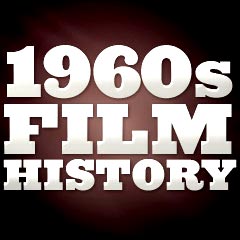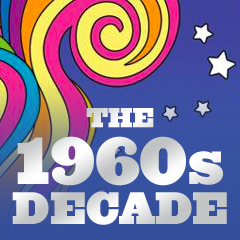|
The Invasion of British Cinema:
 Increasing
American interest in British fads, fashion, and culture coincided with
the smash-hit period comedy and Best Picture-winning Tom Jones (1963)
that was based on the hero of Henry Fielding's classic novel. [The adapted
screenplay was written by John Osborne - known for his earlier work for
the socially-realistic Look Back in Anger (1959).] Its win of four
Oscars (including Best Picture) and six other nominations in 1963 took
everyone by surprise - Tony Richardson's British film was an especially
appealing, free-spirited, 'Swingin' Sixties' film because of its bawdy,
slapstick attitude toward sex seen through the misadventures of a lusty
youth (Albert Finney) in 18th century England. Increasing
American interest in British fads, fashion, and culture coincided with
the smash-hit period comedy and Best Picture-winning Tom Jones (1963)
that was based on the hero of Henry Fielding's classic novel. [The adapted
screenplay was written by John Osborne - known for his earlier work for
the socially-realistic Look Back in Anger (1959).] Its win of four
Oscars (including Best Picture) and six other nominations in 1963 took
everyone by surprise - Tony Richardson's British film was an especially
appealing, free-spirited, 'Swingin' Sixties' film because of its bawdy,
slapstick attitude toward sex seen through the misadventures of a lusty
youth (Albert Finney) in 18th century England.
The Fabulous Four Beatles, who had invaded the US with
Beatlemania in 1963 and 1964 with their pop music made two semi-documentary
musical films: (1) director Richard Lester's fast-paced, inventive rock
'n' roll comedy A Hard Day's Night (1964) (filmed in only eight
weeks after the Beatles' return to England) - a day in the life of the
band, and (2) the energetically zany Help! (1965). A few years
later, a third Beatles-related film, the UK's animated, kaleidoscopic
fantasy musical Yellow Submarine (1968) with a score by George
Martin, featured a Nowhere Man, actors' voices standing in for the actual
Beatles, and an invasion of Blue Meanies on Pepperland.
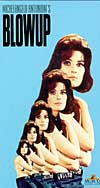 Other
British films such as John Schlesinger's Darling (1965) and Far
From the Madding Crowd (1967), Georgy Girl (1966), and Lewis
Gilbert's sex comedy Alfie (1966) gave international attention
to actors like Julie Christie, Lynn Redgrave and Michael Caine (also Vanessa
Redgrave, Glenda Jackson and others). Oscar-winning Maggie Smith starred
in The Prime of Miss Jean Brodie (1969), a film set in 1930s Edinburgh
about an exceptional, free-thinking teacher whose pupils were "the
creme de la creme." Director Ken Loach's low-budget debut film Kes
(1969) told about an abused 15 year old boy (David Bradley) from the
Yorkshire working classes who found solace with a pet kestrel (falcon). Other
British films such as John Schlesinger's Darling (1965) and Far
From the Madding Crowd (1967), Georgy Girl (1966), and Lewis
Gilbert's sex comedy Alfie (1966) gave international attention
to actors like Julie Christie, Lynn Redgrave and Michael Caine (also Vanessa
Redgrave, Glenda Jackson and others). Oscar-winning Maggie Smith starred
in The Prime of Miss Jean Brodie (1969), a film set in 1930s Edinburgh
about an exceptional, free-thinking teacher whose pupils were "the
creme de la creme." Director Ken Loach's low-budget debut film Kes
(1969) told about an abused 15 year old boy (David Bradley) from the
Yorkshire working classes who found solace with a pet kestrel (falcon).
Blacklisted US director Joseph Losey collaborated with
scriptwriter Harold Pinter and actor Dirk Bogarde (as a sinister and unctuous
manservant named Barrett) to satirize the upper strata of the British
class system in The Servant (1963) and Accident (1967).
But the British film (now a cult classic) that best exemplified the 'swinging'
youth drugs/sex era of late 60s London was co-directors Donald Cammell's
and Nicolas Roeg's originally X-rated Performance (1970) - starring
Rolling Stones rock star Mick Jagger.
The Invasion of Foreign Cinema:
Many of the best and most varied arthouse films came from
foreign directors (from Italy, France, and Japan) during this decade and
were enjoyed (with subtitles) by college students and other sophisticated
metropolitan audiences, such as:
- Federico Fellini's La Dolce Vita (1960) and
8 1/2 (1963)
- Jean-Luc Godard's A Bout De
Souffle (1960) (aka Breathless)
- Michelangelo Antonioni's L'Avventura (1960)
and Blow-Up (1966)
- Francois Truffaut's Shoot the Piano Player (1960)
and Jules Et Jim (1962)
- Alain Resnais' Last Year at Marienbad (1961)
- Akira Kurosawa's Yojimbo (1961) and Sanjuro
(1962)
- Luchino Visconti's The Leopard (1963)
- Ingmar Bergman's Persona (1966)
- Luis Bunuel's Viridiana (1961), Belle De
Jour (1967) and Tristana (1970)
- Jean-Pierre Melville's Le Samourai (1967)
- Jacques Tati's Playtime (1967)
Many famous European directors (Antonioni, Truffaut, Polanski)
produced their cinematic works in Britain during the decade: Italian director
Michelangelo Antonioni filmed the enigmatic, complex and thought-provoking,
existential murder-mystery Blow-Up (1966),
a tale of an over-sexed London fashion photographer (David Hemmings) -
it was Antonioni's first English language film and his most commercially-acceptable
film. [It was released without a Production code seal because it was the
first feature film to show a full-frontal flash of female pubic hair.]
 French
director Francois Truffaut's first film in English was Ray Bradbury's
science-fiction drama Fahrenheit 451 (1966) (with future director
Nicolas Roeg as cinematographer). After his first
feature film Knife in the Water (1962, Pol.), Polish director Roman
Polanski went to England and made his first English-language film
- the imaginatively-nightmarish, surrealistic classic Repulsion (1965)
with Catherine Deneuve as a young, sexually-repressed London hairdresser
who slowly descended into madness, and then later to America to make his
first American film Rosemary's Baby (1968)
adapted from Ira Levin's novel - the colorful thriller about a coven of
Satanistic witches in New York City interested in Mia Farrow's unborn
devil-baby after her husband made a deal with Satan. French
director Francois Truffaut's first film in English was Ray Bradbury's
science-fiction drama Fahrenheit 451 (1966) (with future director
Nicolas Roeg as cinematographer). After his first
feature film Knife in the Water (1962, Pol.), Polish director Roman
Polanski went to England and made his first English-language film
- the imaginatively-nightmarish, surrealistic classic Repulsion (1965)
with Catherine Deneuve as a young, sexually-repressed London hairdresser
who slowly descended into madness, and then later to America to make his
first American film Rosemary's Baby (1968)
adapted from Ira Levin's novel - the colorful thriller about a coven of
Satanistic witches in New York City interested in Mia Farrow's unborn
devil-baby after her husband made a deal with Satan.
In the 1960s, Czechoslovakian film-maker Milos Forman's
Loves of a Blonde (1965) was nominated for a Best Foreign Film
Oscar, followed soon after by the social satire of the Czech New Wave
titled The Fireman's Ball (1967) -- before he emigrated to Hollywood
and made his first American film there, Taking Off (1971).
Italian director Bernardo Bertolucci's first feature films
were The Grim Reaper (aka La Commare secca) (1962), followed by
Before the Revolution (aka Prima della rivoluzione) (1964), released
in 1971, but it would be in the next decade that he would make a name
for himself with Last Tango in Paris (1972). Inventive Italian
director Mario Bava churned out a number of horror films in the 60s, including
his best known and most influential film and his first solo directorial
effort, the macabre The Mask of Satan (aka Black Sunday) (1960),
starring gothic horror queen Barbara Steele as the evil witch Princess
Asa. The film was banned in Great Britain until 1968 and released in a
censored (and re-dubbed) version in the US. In the same time period, Egyptian-born
Riccardo Freda was also pioneering Italian horror-fantasy films, including
I Vampiri (1957) (aka Lust of the Vampire), and L'Orribile
Segreto Del Dottor Hichcock (aka The Horrible Secret of Dr Hichcock) (1962).
He also directed the sword 'n' sandal film The Giants of Thessaly (1960),
a variant of the Jason and the Golden Fleece tale.
German New Wave director Werner Herzog experimented with
films in the 60s, i.e., Signs of Life (1968), and then directed
his first masterpiece Aguirre: The Wrath of God (1972) with Klaus
Kinski in the 70s. New German cinema's auteur Rainer Werner Fassbinder
had only limited success with his early films in the late 60s, until he
found international successes in the 70s with Ali: Fear Eats the Soul
(1973) and The Marriage of Maria Braun (1979).
Stanley Kubrick's Prolific Decade:
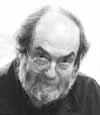 The
most distinguished "British" films of the decade were from one of the
most original, visionary and controversial of directors - Stanley Kubrick.
Kubrick's first three feature films were in the 50s: The
most distinguished "British" films of the decade were from one of the
most original, visionary and controversial of directors - Stanley Kubrick.
Kubrick's first three feature films were in the 50s:
He opened the 60s decade with his first Hollywood
production: Spartacus (1960), a thrilling, historical epic about
a slave revolt in Ancient Rome - another film designed to wrest viewers
away from their small-scale televisions. [The covert homosexuality seduction-bathing
scene between Crassus (Laurence Olivier) and slave Antonius (Tony Curtis),
dubbed the 'snails and oysters' scene, was censored.] Producer and star
actor Kirk Douglas had a falling out with the original director Anthony
Mann, and replaced him with Kubrick, who ended up having little artistic
control over the film. Douglas also promoted the use of blacklisted screenwriter
Dalton Trumbo's name onscreen - it was Trumbo's first screen credit
in over ten years, now that the blacklist was ending after 13 years (Trumbo
became the first blacklisted screenwriter to receive screen credit).
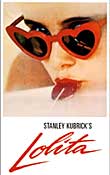 Kubrick's
next two remarkable films, considered somewhat anti-Hollywoodish, were
both filled with dark visions of social and political institutions during
the tense Cold War era: Kubrick's
next two remarkable films, considered somewhat anti-Hollywoodish, were
both filled with dark visions of social and political institutions during
the tense Cold War era:
- Lolita (1962), a satirical
adaptation of Vladimir Nabokov's brilliant novel about a sexually-obsessed
academic named Humbert Humbert (James Mason) who married a widow (Shelley
Winters) to be close to her "nymphet" daughter (Sue Lyon)
- the Cold War black comedy Dr.
Strangelove: Or, How I Learned to Stop Worrying and Love the Bomb (1964)
about a possible nuclear Armageddon at the hands of inept politicians,
arrogant scientists, and military figures with lunatic concerns about
fail-safe points, hotlines, and Communist plots such as flouridation
(Gen. Jack D. Ripper's fear as portrayed by Sterling Hayden). Peter
Sellers was memorable as he played three roles (including the title
role) in the film, as was Slim Pickens in the role of the bomb-riding
pilot who directed the H-bomb to its target - rodeo-style. One of the
film's most memorable quotes was the President's admonition: "Gentlemen,
you can't fight in here. This is the War Room!"
 Kubrick's last film in the 60s was the most successful science fiction
film of the decade with a story that spanned all of human history with
giant leaps (from pre-historic cave-dwelling apes jump-cutting ultimately
to futuristic outer space travelers to Jupiter). A continuing theme was
the reception of an extra-terrestrial signal in its portrayal of man (bored
in his technological paradise) confronting technology beyond his control.
His film, based on the novel by Arthur C. Clarke, was the majestic, Super
Panavision 2001: A Space Odyssey (1968)
with its spectacular visuals, landmark special effects, classical music,
psychedelic, light-show ride (that appealed to late 60s 'tripping' viewers)
and the memorable, flawed HAL supercomputer (with the uncredited voice
of Douglas Rain).
Kubrick's last film in the 60s was the most successful science fiction
film of the decade with a story that spanned all of human history with
giant leaps (from pre-historic cave-dwelling apes jump-cutting ultimately
to futuristic outer space travelers to Jupiter). A continuing theme was
the reception of an extra-terrestrial signal in its portrayal of man (bored
in his technological paradise) confronting technology beyond his control.
His film, based on the novel by Arthur C. Clarke, was the majestic, Super
Panavision 2001: A Space Odyssey (1968)
with its spectacular visuals, landmark special effects, classical music,
psychedelic, light-show ride (that appealed to late 60s 'tripping' viewers)
and the memorable, flawed HAL supercomputer (with the uncredited voice
of Douglas Rain).
In the next decade, Kubrick would go on to make the controversial
A Clockwork Orange (1971), and a visually-stunning,
18th century England period adaptation of the Thackeray novel about an
Irish gambler, Barry Lyndon (1975).
Cold War Political Dramas:
Contemptuous or politically-satirical films portrayed
the American military situation in a bleak, nightmarish light in the 60s:
- Jack Arnold's political satire The Mouse That Roared
(1959), with Peter Sellers acting in three roles (one of which was
the leader of an invading force upon the US)
- Billy Wilder's satirical political farce One, Two,
Three (1961), based on Ferenc Molnar's play and with a screenplay
by Wilder and I.A.L. Diamond, about a Coca Cola executive (James Cagney)
whose job was jeopardized when his boss' daughter (Pamela Tiffin) married
an East Berlin Communist (Horst Buchholz)
- John Frankenheimer's black and white conspiratorial
political-military drama-thriller Seven Days in May (1964) about
an attempted military coup, adapted by Twilight Zone's Rod Serling
from the novel by Fletcher Knebel and Charles Waldo Bailey II; with
Fredric March as the President and Burt Lancaster as the Chairman of
the Joint Chiefs of Staff
- the apocalyptic disaster drama about nuclear war, Sidney
Lumet's Fail-Safe (1964), adapted from the novel by Eugene Burdick
and Harvey Wheeler, with Henry Fonda as the US President
- the UK's tense The Spy Who Came in From the Cold
(1965) adapted from John Le Carre's tale of espionage, with Oscar-nominated
Richard Burton as a disillusioned and betrayed British Cold War spy-agent after entering into E. Germany to trap his communist counterpart
- Jack Cardiff's espionage film The Liquidator (1966),
based on John Gardner's novel and a parody of the James Bond films
- Theodore J. Flicker's political satire The President's
Analyst (1967), starring James Coburn as the title character
- Howard Morris' Don't Drink the Water (1969),
based on a play by Woody Allen
- director/writer William Klein's angry political fantasy
satire, Mister Freedom (1969) in the form of a American comic-strip
super hero who must save France from the Communists (Klein was best
known for his documentary Muhammad Ali, the Greatest (1969))
Golden Age Directors: The End of an Era
 Some
of the greatest directors from Hollywood's golden era were experiencing
their swan songs during this decade. Many of them, including King Vidor,
Raoul Walsh, Michael Curtiz, John Ford, and Howard Hawks, directed their
last, lesser-known films in the 60s. For example, King Vidor's last
film in the last year of the previous decade was filmed in Spain - the
biblical spectacle Solomon and Sheba (1959) starring Yul Brynner
and alluring Italian star Gina Lollobrigida. Frank Capra's last
feature film was Pocketful of Miracles (1961) - a remake of his
Lady for a Day (1933). Orson Welles was struggling in the 60s,
although still directing films, such as the adaptation of Kafka's The
Trial (1962) with Anthony Perkins, and Chimes at Midnight/Falstaff (1966)
in which he starred as Shakespeare's Falstaff. Some
of the greatest directors from Hollywood's golden era were experiencing
their swan songs during this decade. Many of them, including King Vidor,
Raoul Walsh, Michael Curtiz, John Ford, and Howard Hawks, directed their
last, lesser-known films in the 60s. For example, King Vidor's last
film in the last year of the previous decade was filmed in Spain - the
biblical spectacle Solomon and Sheba (1959) starring Yul Brynner
and alluring Italian star Gina Lollobrigida. Frank Capra's last
feature film was Pocketful of Miracles (1961) - a remake of his
Lady for a Day (1933). Orson Welles was struggling in the 60s,
although still directing films, such as the adaptation of Kafka's The
Trial (1962) with Anthony Perkins, and Chimes at Midnight/Falstaff (1966)
in which he starred as Shakespeare's Falstaff.
John Ford's last three films included the revisionistic
The Man Who Shot Liberty Valance (1962),
a bleak and dark vision of the West starring John Wayne as the
unsung hero, Lee Marvin as the title character-villain, and James
Stewart as the falsely-honored killer of the outlaw gunman - and
advertised with the statement that legend was more important than
truth: ("When
the legend becomes fact, print the legend"), and Ford's last
epic western Cheyenne
Autumn (1964) - about the awful trek of three hundred Cheyenne
Indians from Oklahoma to their ancestral home in Wyoming.
Walsh's last work was A Distant Trumpet (1964), and veteran
director Hawks ended his long career with Red Line 7000 (1965) and El
Dorado (1967)
with macho stars John Wayne and Robert Mitchum. With the end of
the era, the old film masters were finally being acclaimed as
true auteurs
by writers/directors of the French New Wave.
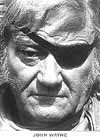 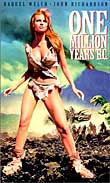 At
the end of the decade, in homage to one of the greatest Western stars
in cinematic history, director Henry Hathaway saluted John Wayne with
True Grit (1969) - a film for which Wayne, as one-eyed, pot-bellied
Marshal Rooster Cogburn, received deserved critical recognition and a
sentimental Academy Award for Best Actor - his first and
sole Oscar victory. At
the end of the decade, in homage to one of the greatest Western stars
in cinematic history, director Henry Hathaway saluted John Wayne with
True Grit (1969) - a film for which Wayne, as one-eyed, pot-bellied
Marshal Rooster Cogburn, received deserved critical recognition and a
sentimental Academy Award for Best Actor - his first and
sole Oscar victory.
Producer/director George Pal's The Time Machine (1960)
with Oscar-winning visual effects was based on the H.G. Wells tale, and
starred Rod Taylor as the traveler to the year 802,701 in a world populated
by Morlocks and Elois. Creative special-effects master Ray Harryhausen
developed his legendary stop-motion animation techniques to perfection
in his best science-fiction film ever - director Don Chaffey's Jason
and the Argonauts (1963). Chaffey also directed Raquel Welch in a
furry bikini (boosting bikini sales), who followed banished tribesman
Tumak in Hammer Studios' unbelievable One Million Years BC (1966)
(a remake of the 1939 prehistoric adventure with Victor Mature), featuring
Harryhausen's animated dinosaurs.
 Film History of the 1960s
Film History of the 1960s
Part 1, Part 2, Part 3, Part 4, Part 5, Part 6

 
|
